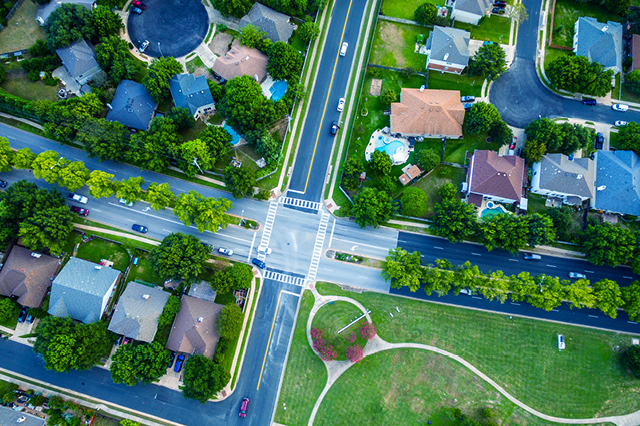Should we continue to embrace density post COVID-19?
In modern times, Australian cities and many around the world have strived to achieve greater urban densification. This is a trend driven by both the prevailing wisdom of the times and by necessity.
Suddenly, the COVID-19 pandemic has raised fundamental questions about urban density and its risks and values. In some quarters, we have seen a 'reactionary rethinking'1 of densification, fuelled by suggestions that density renders cities more vulnerable to pandemics and is therefore dangerous. Indeed, many efforts to control the outbreak to date have focused on what are essentially 'de-densification' strategies: closures of schools, workplaces, restaurants and shopping centres were each means of reducing density in a bid to fight the virus' spread.2
Current research does not show a consistent link between the density of cities and COVID-19 impacts.3 Yet with the focus currently on de-densification, the question remains: should we continue to embrace density post COVID-19?
Urban density is still good for us
In our view, it would be a mistake to turn our backs on decades of planning policy supporting increased urban densification, in response to COVID-19. Density continues to provide a multitude of benefits. Density:
- supports the efficient provision of public infrastructure and services;
- facilitates mass transportation, creates walkable cities and vibrant commercial districts;
- delivers greater employment opportunities;
- allows for more affordable housing; and
- helps us achieve better environmental, ecological and sustainability outcomes.4
Further benefits are evident during a pandemic: density allows cities to concentrate vital resources and social services where they are needed most. In turn, residents can have faster access to hospitals and healthcare as well as 'social infrastructure' – such as community spaces and public parks – which can foster social ties and reduce isolation in times of crisis.5
Where to from here?
Densification supported by appropriate infrastructure and services should remain an essential feature of our strategic planning policies, to enable successful, high-amenity urban environments. The issue is how urban density should be planned and managed in a post COVID-19 landscape.
The future development of cities will involve competing considerations of public health, environmental and socio-economic factors.6 Undoubtedly, urban planning will have to evolve to consider densification from an infectious disease viewpoint.
However, to reject urban density altogether would result in a disappointing loss of the many environmental, economic, health and social benefits that densification has to offer. We consider below a number of ways that planning law and policy could respond in defence of densification.
1. Work on density's 'image problem'
First and foremost, policymakers must acknowledge that urban density has suffered an 'image problem' as a result of the COVID-19 pandemic, and take steps to rehabilitate that image. For some, the thought of high-density living may evoke images of small living spaces, a lack of public and private open space, and crowded urban areas – images out of step with the realities of life during and potentially after a pandemic. Urban planning must respond to these concerns and take concrete actions to reassure the public that densification can be safe, comfortable and desirable.
Part of this rehabilitation exercise requires taking steps that demonstrably place public health considerations at the forefront of planning and design. For example, planning and design measures could mandate wider footpaths and bigger lifts and corridors to facilitate physical distancing, a greater focus on adequate cross-ventilation and natural lighting indoors, and automated doors, lifts and crosswalks to minimise virus transmission.
Other steps could include urban design that prioritises open green space, walkability, good and safe access to public transport and a range of housing options. Going forward, greater attention should also be given to community views on what density, if well-executed, should look like. Community consultation in the early stages of high-density development will be key to shaping an image of safe, high-amenity urban densification.
2. Discourage knee-jerk anti-density responses
As we transition to COVID normal, measures should be put in place to prevent unduly anti-density local decisions being made in reaction to the pandemic. For example, planning policies and guidance could include express recognition that development projects should not be rejected merely on ground that density is undesirable in a pandemic or due to public health concerns that can be appropriately remediated through physical distancing mechanisms.
To encourage further urban densification, governments and councils should also continue to revisit policies to consider incentives for construction of housing options other than free-standing homes (eg build to rent, apartments and medium-density complexes). This may not be confined to planning policies, but could also extend to financial incentives such as grants and tax breaks.
3. Harness the opportunity for a brighter urban future
COVID-19 presents a golden opportunity to strive for something better: to improve on current urban planning policies and not settle for a return to pre-pandemic traditional high-density living models. Going forward, high-quality urban development outcomes could be facilitated, for example, by stronger design requirements for residential and commercial buildings, which prioritise space and amenity above 'densification at all costs'. Additionally, planning policy regarding the provision of open green spaces and private outdoor areas could be strengthened.
Governments may also consider reviewing and amending planning zones to allow greater diversity of housing options in built-up areas, with a focus on proximity to services and public transport. With COVID-19 having reinforced the importance of social and community bonds, planning policy could respond by prioritising community infrastructure and public areas where people can socialise and connect safely and comfortably.
Though the COVID-19 outbreak may bring with it temptation to give up on densification, we must not do so. In these extraordinary times, we should remain steadfast in our pursuit of appropriate urban densification and the many economic, social, environmental and health benefits it provides. Density, not its rejection, is essential to shaping sustainable, vibrant and resilient Australian cities now and in the future.
Footnotes
-
Ian Klaus, The Post-Pandemic Urban Future Is Already Here (6 April 2020) CityLab https://www.citylab.com/design/2020/04/coronavirus-urban-planning-cities-architecture-history/609262/.
-
Ibid; Michael Hooper, Pandemics and the future of urban density: Michael Hooper on hygiene, public perception and the “urban penalty” (13 April 2020) Harvard University Graduate School of Design https://www.gsd.harvard.edu/2020/04/have-we-embraced-urban-density-to-our-own-peril-michael-hooper-on-hygiene-public-perception-and-the-urban-penalty-in-a-global-pandemic/
-
Robert Steuteville, Facts don't support the ‘density is dangerous’ narrative (23 March 2020) Public Square: A CNU Journal https://www.cnu.org/publicsquare/2020/03/23/plague-don%E2%80%99t-count-cities-out; Shima Hamidi, Sadegh Sabouri and Reid Ewing, 'Does Density Aggravate the COVID-19 Pandemic?' (2020) 86:4 Journal of the American Planning Association 495-509.
-
Emily Badger, Density Is Normally Good for Us. That Will Be True After Coronavirus, Too. (24 March 2020) The New York Times https://www.nytimes.com/2020/03/24/upshot/coronavirus-urban-density-risks.html.
-
Ibid; Samuel Kling, Is the City Itself the Problem? (20 April 2020) CityLab https://www.citylab.com/perspective/2020/04/coronavirus-cases-urban-density-suburbs-health-parks-cities/610210/
-
Ashraf M. Salama, Coronavirus questions that will not go away: interrogating urban and socio-spatial implications of COVID-19 measures (16 April 2020) Emerald Open Research https://emeraldopenresearch.com/articles/2-14/v1







